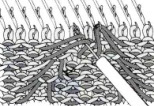Most pubs include variations of sequences such as in this illustration showing the first float traveling under subsequent ones.  This chart visualizing the process for a specific repeat was generated using Mac Numbers.
This chart visualizing the process for a specific repeat was generated using Mac Numbers.
The side edges need to be planned for the best effect, the columns marked with yellow cells indicate possible repeat starts and stops.
The 8X16 design is suitable for use on electronic and punch card models,  A minimum punchcard repeat is 24stitches X32 rows
A minimum punchcard repeat is 24stitches X32 rows ![]() This swatch was knit using a chenille yarn for weaving, its fibers expand as the fabric rests, lessening the space that can enhance the definition between the floats
This swatch was knit using a chenille yarn for weaving, its fibers expand as the fabric rests, lessening the space that can enhance the definition between the floats
 Translating published patterns sometimes requires testing the process by hand-selecting needles to develop programmable DIY designs. The Brother cassette knitting pattern book
Translating published patterns sometimes requires testing the process by hand-selecting needles to develop programmable DIY designs. The Brother cassette knitting pattern book  includes a series of samples utilizing the technique, and these illustrations
includes a series of samples utilizing the technique, and these illustrations
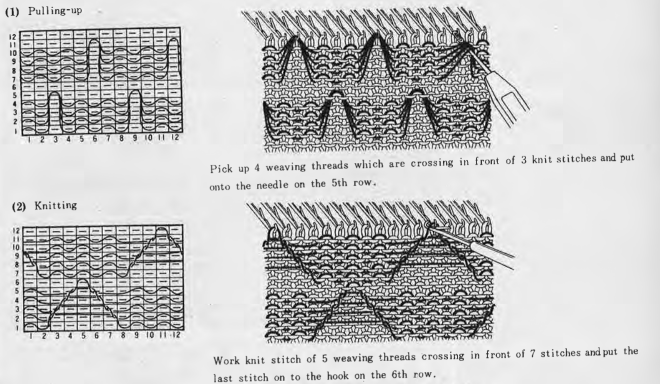 In fabrics such as these, the latch hook is inserted under floats from the first formed up, the last float is caught in the hook of the tool, pulled down behind them, brought forward, up, and lifted onto specific needle locations before further weaving or plain knitting resumes on all needles in work.
In fabrics such as these, the latch hook is inserted under floats from the first formed up, the last float is caught in the hook of the tool, pulled down behind them, brought forward, up, and lifted onto specific needle locations before further weaving or plain knitting resumes on all needles in work.  A random selection:
A random selection:  The repeats are represented in a clockwise rotation,
The repeats are represented in a clockwise rotation, 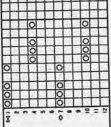 the first swatch however, disregarded that fact and was a best guess at DIY based on hand-selection of needles.
the first swatch however, disregarded that fact and was a best guess at DIY based on hand-selection of needles.
As already mentioned, the latch tool is used to slide under the first 3 floats grabbing the yarn in the newly created longer float, bringing it under and then to the front of the group of three, and the single loop in the tool hook is lifted onto the hook of the needle in the center position between groups of newly preselected needles. That needle must be pushed back to the B position before knitting the next row so as not to pick up the weaving yarn.  the 6X8 repeat
the 6X8 repeat 
![]() The swatch on the left is the result of hand selection, and to its right both sides of the result from knitting with the programmed repeat
The swatch on the left is the result of hand selection, and to its right both sides of the result from knitting with the programmed repeat 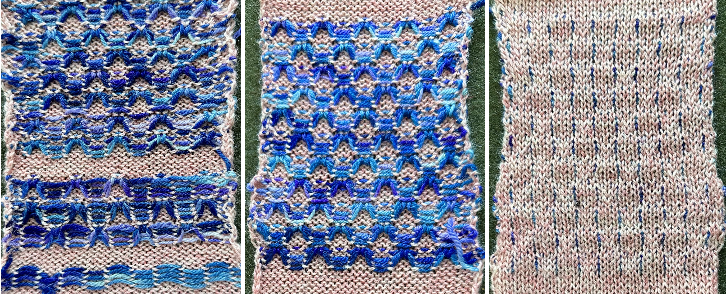 As a general principle when multiple colors are used, if they are planned for color changes occurring for odd numbers of passes, the yarn may need to be cut and brought to the opposite side regularly, or 2 different ends starting from opposite sides may in some cases make the process easier and reduce yarn ends.
As a general principle when multiple colors are used, if they are planned for color changes occurring for odd numbers of passes, the yarn may need to be cut and brought to the opposite side regularly, or 2 different ends starting from opposite sides may in some cases make the process easier and reduce yarn ends.
For speed and ease in tracking, the compromise choice can be made to change the repeat so that actions happen after knitting even numbers of rows.
End needle selection is on with selective hand moving end needles out to catch the weaving yarn if the repeat is used as provided.
A new, 6X8 repeat: ![]() the 24X40 full punchcard,
the 24X40 full punchcard, ![]() If programming the width of the finished piece on electronic machines, pixels for border needle selections can be added, knit with end needle selection off.
If programming the width of the finished piece on electronic machines, pixels for border needle selections can be added, knit with end needle selection off. ![]() Some steps in the process, with # 4 showing the single chained through loops rehung across the row
Some steps in the process, with # 4 showing the single chained through loops rehung across the row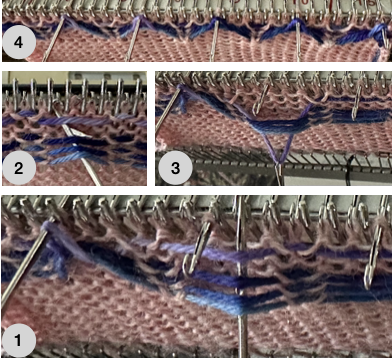 The 930 automatically mirrors any design horizontally. When an odd-numbered design is downloaded and centered with no subsequent changes, the odd-number half of the repeat occurs on the right of 0.
The 930 automatically mirrors any design horizontally. When an odd-numbered design is downloaded and centered with no subsequent changes, the odd-number half of the repeat occurs on the right of 0.
The proof of concept was knit on needles 20 L to 21 R 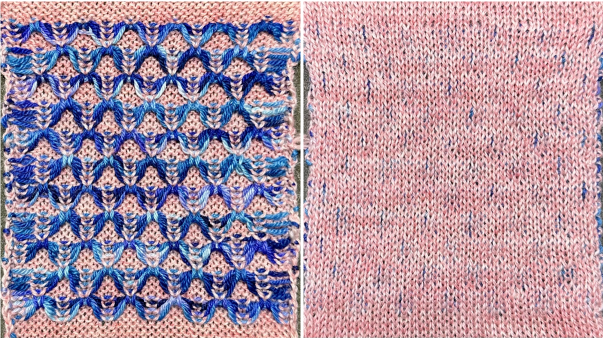 Here the background yarn is switched to a far thinner cotton, making the woven threads and their bleed-through on the knit side more prominent. In a final piece planned for this effect, side borders could be planned for better edges.
Here the background yarn is switched to a far thinner cotton, making the woven threads and their bleed-through on the knit side more prominent. In a final piece planned for this effect, side borders could be planned for better edges. 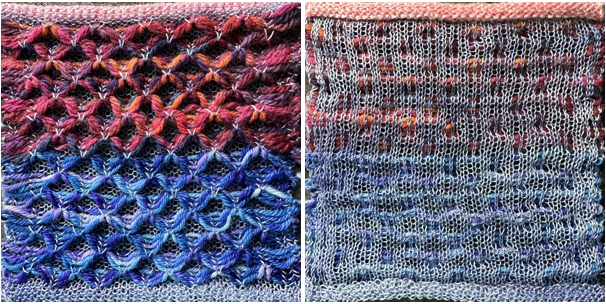 From a Brother electronic pub, an illustration of hooking up multiple loops at once
From a Brother electronic pub, an illustration of hooking up multiple loops at once  If the needle onto which the floats are transferred is left in work, it will pick up the weaving yarn on the next pass as part of the design and should remain in D or be pulled to E position if preferred. If that is not the goal, that same needle is pushed back to the B position.
If the needle onto which the floats are transferred is left in work, it will pick up the weaving yarn on the next pass as part of the design and should remain in D or be pulled to E position if preferred. If that is not the goal, that same needle is pushed back to the B position.  Just as in managing long floats in FI, in this fabric, they may be latched up as well
Just as in managing long floats in FI, in this fabric, they may be latched up as well  Lifting the stitch in the latch hook onto a needle other than in the center of the space between needle selection or one of the preselected needles, will result in the chain moving permanently in different directions.
Lifting the stitch in the latch hook onto a needle other than in the center of the space between needle selection or one of the preselected needles, will result in the chain moving permanently in different directions.
A second early resource for samples of these techniques  offered this version along with advice on how to knit it. Such translations are not always understandable.
offered this version along with advice on how to knit it. Such translations are not always understandable. 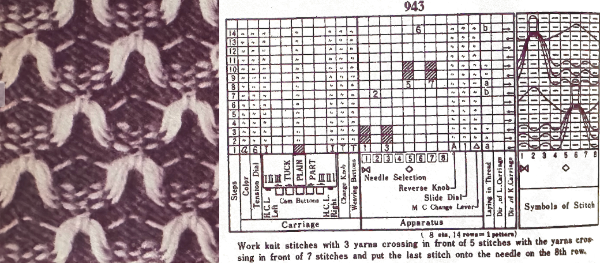 Based on row counts of patterning in the accompanying swatch it is possible to develop a repeat by assigning black pixel locations to specific squares in the stitch symbol chart rather than using the repeat provided.
Based on row counts of patterning in the accompanying swatch it is possible to develop a repeat by assigning black pixel locations to specific squares in the stitch symbol chart rather than using the repeat provided.
The horizontal marks for purl stitches can be thought of as needles on the machine.
The squares where the traveling weaving thread “wave” in the position above the line are filled are represented with green cells in the spreadsheet and will be converted to black pixels in BW pngs for use in download programs, or punched holes in cards.
The under “waves” symbolize floats and are disregarded in final repeats.
Yellow is used to mark spots for visual reminders of where the floats are to be rehung. They are disregarded in the final BW single repeat. The corresponding needles in those locations must pushed back to the B position before knitting the next row.
 The 8X14 smallest repeat
The 8X14 smallest repeat ![]() was tested on 48 stitches hand selecting end needles if needed.
was tested on 48 stitches hand selecting end needles if needed.  Working in vertical columns, a 9X12 design
Working in vertical columns, a 9X12 design ![]() planned on 39 stitches for equal side edges
planned on 39 stitches for equal side edges  the floats are lifted in pairs every 2 rows, in alternate directions onto preselected needles, which can be brought out to the E position after the transfer. Those needles are marked with red dots.
the floats are lifted in pairs every 2 rows, in alternate directions onto preselected needles, which can be brought out to the E position after the transfer. Those needles are marked with red dots.  The swatch was knit in wool yarns of equal weight. The weaving yarn split easily. Each row should be checked for any errors after hooking before continuing to knit to avoid permanent errors. The result of both is marked with red dots in the photo on the left
The swatch was knit in wool yarns of equal weight. The weaving yarn split easily. Each row should be checked for any errors after hooking before continuing to knit to avoid permanent errors. The result of both is marked with red dots in the photo on the left  In summary, black squares indicate yarn over selected needles, and white squares the yarn slipping under non-selected needles, represented in this chart for a 2X2 design repeat/ paintbrush in DIY.
In summary, black squares indicate yarn over selected needles, and white squares the yarn slipping under non-selected needles, represented in this chart for a 2X2 design repeat/ paintbrush in DIY. ![]()
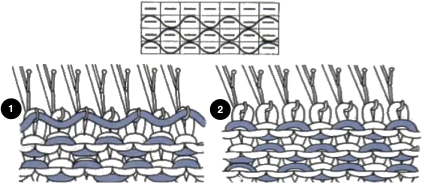 Side by side punched holes or black pixels produce floats in a corresponding stitch width. Blocks of either color can be planned in any direction, with the floats left alone as color blocks or manipulated to echo their movement ie in this illustration
Side by side punched holes or black pixels produce floats in a corresponding stitch width. Blocks of either color can be planned in any direction, with the floats left alone as color blocks or manipulated to echo their movement ie in this illustration 